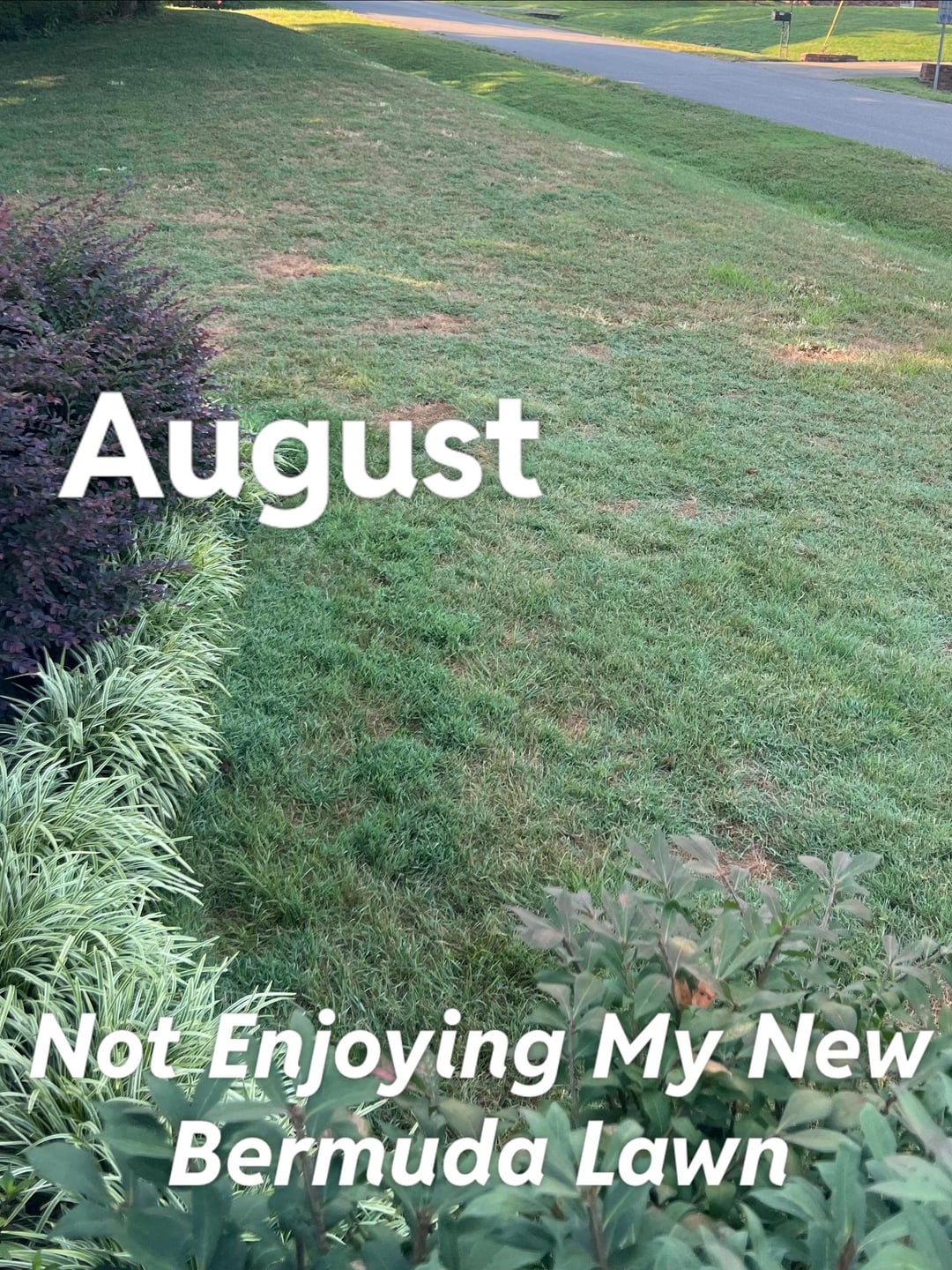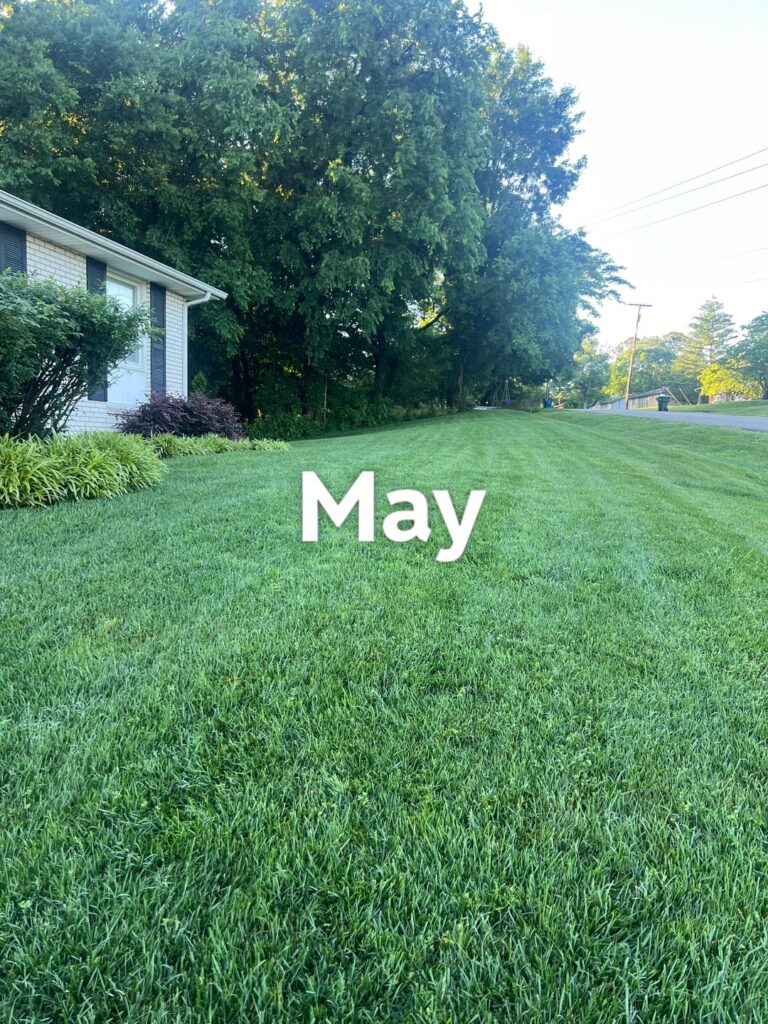



Trying to understand how this and get a plan for the fall.
This is in zone 7A -transition zone-
Timeline:
– Last fall planted GCI TTTF
– Germinated great and had an incredible lawn until mid June.
- June we got a lot of rain and I realized I may be getting fungus, so I applied disease ex at curative rate, and then 2 weeks later did the bio-advanced at curative rate.
-Fescue just kept looking worse despite us getting rain and treating with fungicide
-Bermuda starts to come up in July and has taken over the damn yard. Probably 70% coverage.
-Almost all of the fescue in the main yard seems dead and the Bermuda is doing its thing.
Questions:
Did I torch the fescue with the fungicide? (It was around 90 degrees when I had to apply it)
Is it worth getting a specific Bermuda herbicide and start spraying now? Or just glyphosate and do another full reseed this fall?
Fescue Is Beta and it’s probably not worth the trouble.
by Fescue_Is_Beta


48 Comments
It got hot out.
Mine looks exactly like this in 7a MD. Wish I didnt go TTTF and went KBG or something else. There’s no way TTTF is the most drought resistant when its the first thing to go
I think you just didn’t water wnough
I’m in 7a as well and have had a lot of trouble with new TTTF in our front yard. I also have a Bermuda problem just like you. I will do it all over again in many spots, but this time I will be using liquid products to help strengthen and hydrate the root system. That was the one thing I didn’t do this season. I’m not so sure if the fungicide did that, more than likely heat stress overall. My goal for our lawn is to get the roots as strong as possible to withstand 90+ degree summers. Any well established grass we have has survived this summer. The newer grass no so much.
What type of tttf? Some cultivars are very susceptible to patch diseases.
Can we stop it with the fungus nonsense? Jeez, y’all.
It got hot. Bermuda has blessed your space. There are worse things to have on your lawn.
It was cut too short for the amount of heat and water it received after being cut. Watering more in the warmer months or not cutting it as short in those months will help for the next season
Summer
you guys would shit yourself if you saw my fescue lawn in Texas, in between 9a/9b 🤠 lmao
it’s still sorta green but I also spray it about 5 minutes every afternoon and drench it on the weekly watering day.
for those wondering, I just took this picture 5 minutes ago(the yellow spots are just the sun poking through the trees because it’s 1:30pm :
https://preview.redd.it/powl43w2k1if1.png?width=1080&format=png&auto=webp&s=04a40e8fe60f01d44d7b458faa111c5c8efa2628
3.5″ mow height, looked a lot nicer in april 😭
For 9a/b area (pretty much right in between), for this being fescue, I think it’s pretty damn impressive.
pretty wild how it’s basically not even growing right now. that’s not so bad though lol
Let the Bermuda thrive. Overseed rye in the fall if you want green all year long.
H2O
If it were me I would focus on my new Bermuda lawn and cut losses on the fescue. Sure you can battle to get the fescue to grow, or sit back relax and enjoy a Bermuda lawn. One lawn type is dying while another is thriving. Not a hard choice on which one your zone prefers.
keeping the deep soil watered. Get a sprinkler anduse dawn/dusk showers. Right now it looks toast, try dethatching everything burnt and aerate the soil (If you want, reseed and level the yard more with sand or soil). Getting water deep in the soil should help bring things back. After, routine showers should keep it hydrated.
Heat
Not enough water and cutting too short.
Fungus. Same thing happened to my yard. Wettest Spring on record. Kept up with fertilizing, kept up with weed control, and had never heard of lawn fungus. Huge mistake. Yard turned into all weeds. I hired a professional. I have brown patch and dollar spot.
What went wrong is tall fescue is pretty finicky it turns out. I’ve had similar experiences to yours the last two seasons.
It’s always amusing seeing more than 10 comments on these when it only takes one comment to solve the issue.
I think there needs to be a good talk about the zones. First is that zones deal with cold not heat and also the zones are probably off a bit since we have had increasing temps over the last several decades.
For zones you really need to look at summer temps vice what the zone in winter is for hardiness. For example, you could be in zone 7a for winter but a zone 9 type environment in summer. Going off that you would really want warm season grasses because the summers are just too brutal for cool season grass. Plus warm season grasses can generally do ok in cooler zones in the winter.
For the zones being off I would guess that you need to shift them north probably half a zone at this point. For instance I used to live in Norfolk VA which is zone 7b or 8 depending on the map. Thats an average extreme of 10 to 20 degrees. In the 12 plus years I lived there I can count on my hands alone the number of days we had below 20 degrees. We should have been probably a zone 8b or 9a based on that info.
Any sign of grubs or army worms? They eat the roots / blades.
“It’s too damn hot outside!”
You killed it with the fungicide.
Fescues are cool-season grasses. By the time it’s 90 F they’re just holding on at best. They’re probably burning more of their reserves than they’re adding to it through photosynthesis. Overly high humidity probably makes things worse, because plants can use evaporation to cool.
Turf-type tall fescue is [Lolium arundinaceum](https://en.wikipedia.org/wiki/Lolium_arundinaceum), which is more heat and drought tolerant than most cool-season grasses specifically because it hosts a fungal symbiont. So applying fungicide probably killed the symbiont and doomed the grass.
You have to baby cool-season grasses if you want them to establish and survive in that kind of heat.
Looks like if cooked
Slit seed it end of August , by October it’ll be back
Bermuda should be watered deeply, but infrequently
If you have fescue in the south, rain will never be enough.
Water
That’s ok it will come back in cooler temps

Bermuda is winning so why fight it. Keep mowing low while avoiding scalping and following the 1/3 rule. Give it some nitrogen if you have irrigation.
Grass naturally goes dormant and looks like this. Add in drought conditions…
Sunshine and hot air, I think people call it summer.
Look for chinch bug by the “Dog pee” looking areas.
Hey, that’s my lawn.
Look at the difference in the trees from pic 1 to 2. It got hot and maybe not as much rain.
As others have mentioned, you might need to throw in the towel and accept your Bermuda lawn. Everything I’ve read in the past is it’s hard to get rid of and you need special herbicides to kill it. It will keep on coming back. The whole thing with Bermuda is you can mow it really low and get a nice dense carpet like effect.
Usually, once you see fungus in the lawn, it’s already too late. Fungicide will slow it down, but it won’t ever cure it in one application. In those high temps, you might get 2 weeks out of the application. Keep an eye on the weather forecast. If it’s going to get hot, put out the prevention rate just before the weather is hot. I’ve had to apply Azoxystrobin (Disease X) and Propiconazole (Bioadvance for lawns) to keep it at bay. But prevention is always better than curing. I water twice a week for about 60-90 minutes in the early morning. I’m in lower Michigan, and we’ve been hitting 90’s since the beginning of July with only one weeks break lower in the 80s.
https://preview.redd.it/4lmm2t0q12if1.jpeg?width=2560&format=pjpg&auto=webp&s=0bf3bc297274bcf72f16ac49c13a56c0f12a73e6
.
I planted Brarenbrug RPR a few years ago, and it has held up to this heat with a little forethought and good practices for watering. This is a picture of my front yard, and it’s 92°F today.
Heat
I tried for years to have fescue in my partially shaded yard.
Bermuda from adjacent golf course invaded. Tried to kill it multiple times.
Only way to get rid of it is move!
I had the only tree cut down so my yard is full sun
Bermuda does great
Now i overseed every fall with perennial rye. It is easy to grow.
Burns out in june. Bermuda then takes over
West Kentucky
Im up in zone 3b. It’s cold as crap here. No Bermuda here. I will verify cutting at about 2.75 inches and some timely rains have helped. A lot.
Same thing happens to my lawn every year
The grass is new, so it’s going to struggle its first summer unless you really water it well on a schedule. It doesn’t have the root structure to really keep going
This is my lawn life almost to a tea. Planted fescue last year, looked awesome in May, started looking bad in June, couldn’t figure out if it was fungus, applied fungicide, didn’t help, now it’s complete trash.
It’s really hard getting straight answers from people too, everyone seems to have a different opinion. I wish I could find just one universal resource to refer to.
I’m going to try to buy a disease resistant fescue and start planting again in a couple weeks.
I don’t see why you did a fungus treatment. That looks like hot fescue
Looks very thirsty
June looks mowed too short, needs water, fungal issues. All compounding on each other.
Pretty well looks like mime after a month of no rain coupled with hot temps
no biochar added and heat stress, biochar holds water and keeps roots in moisture.